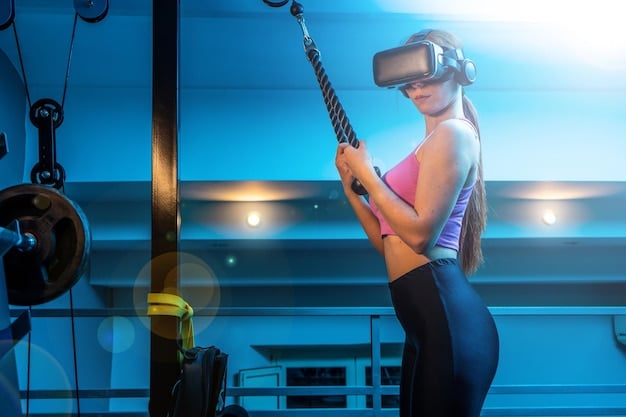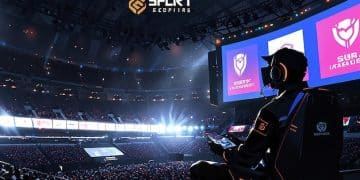The Rise of Esports Training Software: Improve Your Skills by 15% in 3 Months

Esports training software leverages advanced analytics and AI-driven insights to provide personalized practice regimens, enabling competitive gamers to systematically enhance their performance, often leading to significant skill improvement within a few months.
In the dynamic world of competitive gaming, every millisecond and every decision can mean the difference between victory and defeat. For aspiring and professional esports athletes, marginal gains are paramount. This pursuit of perfection has propelled the rise of esports training software: improve your skills by 15% in 3 months, offering a scientific, data-driven approach to skill enhancement that was once the exclusive domain of traditional sports. This isn’t just about playing more; it’s about playing smarter, practicing with purpose, and transforming raw talent into formidable prowess.
The Evolution of Esports Training: Beyond Aim and Mechanics
The landscape of esports training has undergone a profound transformation. What began with rudimentary aim trainers and replay analysis has evolved into sophisticated ecosystems designed to dissect every facet of a player’s performance. Early training largely focused on mechanical skills – precise aiming, rapid button presses, and efficient movement. While these fundamentals remain critical, modern esports encompasses a far broader spectrum of abilities, including strategic thinking, decision-making under pressure, team communication, and mental resilience. This holistic approach demands tools that can quantify and improve these complex, often intangible, aspects of competitive play.
Modern training software goes far beyond simply logging playtime. It integrates with game APIs to capture granular data, from keystrokes and mouse movements to in-game decisions, map awareness, and even communication patterns. This deluge of data is then processed through advanced algorithms, often incorporating machine learning, to identify patterns, pinpoint weaknesses, and recommend targeted training exercises. The software can simulate various in-game scenarios, allowing players to practice specific mechanics or strategic maneuvers repeatedly without the pressure of a live match. This focused, iterative practice is key to embedding new skills and strategies into a player’s muscle memory and cognitive processes. The goal is to move from reactive play to proactive mastery.
Analyzing Performance: Data-Driven Insights
At the core of effective esports training software lies robust performance analytics. These tools break down game sessions into actionable metrics, providing an objective view of a player’s strengths and weaknesses. By identifying statistical anomalies or consistent patterns of error, players can focus their efforts on areas that yield the most significant improvement. For instance, a player might discover they consistently miss critical ability shots in clutch situations, or that their map awareness drops significantly during intense team fights.
These insights are often presented through intuitive dashboards and visual representations, making complex data digestible even for users without a background in statistics. Comparative analytics allow players to benchmark their performance against top-tier professionals or their own historical data, setting concrete goals for improvement.
- Precision Metrics: Tracking aim accuracy, headshot percentage, and recoil control.
- Decision-Making Scores: Evaluating tactical choices, positioning, and engagement timing.
- Map Awareness: Analyzing mini-map usage, ward placement, or objective control.
- Resource Management: Assessing economy, ability cooldowns, and itemization effectiveness.
Personalized Training Regimens: Tailored for Growth
One of the most significant advancements in esports training software is its ability to create highly personalized training regimens. Gone are the days of one-size-fits-all drills. Instead, AI-driven systems analyze a player’s unique performance profile and generate exercises specifically designed to address their identified deficiencies. This tailored approach maximizes the efficiency of practice time, ensuring every session contributes directly to skill development.
For example, a League of Legends player struggling with last-hitting minions might receive focused drills on precise auto-attack timing and wave management. A Valorant player with inconsistent flick shots could be given repetitive, high-intensity aim challenges. This personalization extends beyond mechanical skills to include strategic exercises, cognitive drills, and even mental preparation techniques, all calibrated to the individual’s needs and learning style.
This level of customization transforms practice from a generic grind into a targeted pathway to mastery, accelerating the learning curve for players at all skill levels.
Key Features of Leading Esports Training Software
The market for esports training software has exploded, with various platforms offering a diverse range of features. Understanding these core functionalities is crucial for any player looking to invest in their competitive growth. From real-time feedback to sophisticated replay analysis, each feature plays a vital role in dismantling performance barriers and fostering skill acquisition. The integration of these tools into a seamless user experience is what truly elevates a good training platform to an indispensable asset.
One common thread across leading software solutions is their emphasis on actionable insights. It’s not enough to merely present data; the software must translate that data into practical advice and specific drills. This often involves a feedback loop where players complete exercises, receive immediate performance reports, and then have their next set of drills adjusted based on their progress. This iterative improvement cycle is foundational to the rapid skill acquisition that players seek.

Real-time Performance Metrics and Feedback
Immediate feedback is a cornerstone of effective learning, and esports training software capitalizes on this principle. During live gameplay or dedicated training sessions, these tools can overlay crucial performance metrics directly onto the player’s screen or provide audio cues. This real-time data might include crosshair placement accuracy, damage dealt per second, or engagement timing.
The value of real-time feedback lies in its immediacy. Players can instantly see the impact of their actions and make on-the-fly adjustments. This helps to ingrain correct habits and correct mistakes as they happen, preventing the reinforcement of bad practices. Some advanced systems even offer predictive analytics, suggesting optimal moves based on the current game state, guiding players toward better decision-making under pressure.
Advanced Replay Analysis and Scenario Simulation
Beyond live play, deep dive replay analysis remains a powerful tool. Software platforms allow players to re-watch their games from various perspectives, often with integrated data overlays that highlight key moments, mistakes, or missed opportunities. This post-game analysis is crucial for understanding overarching strategic flaws or consistent errors that might not be apparent in the heat of the moment.
Scenario simulation takes this a step further. Instead of just analyzing past mistakes, players can practice specific situations repeatedly. This might involve replaying a difficult clutch scenario in Counter-Strike or practicing a specific objective push in Dota 2. These simulations strip away the unpredictability of a live match, allowing players to focus solely on perfecting their execution and decision-making within a controlled environment. The ability to isolate and drill complex scenarios accelerates the learning process significantly.
Cognitive Training and Mental Fortitude Drills
Esports isn’t just about mechanical skill; it’s a deeply mental game. Training software is increasingly incorporating modules designed to enhance cognitive functions crucial for competitive play. This includes drills that improve reaction time, information processing speed, attention span, and even memory. These exercises often resemble mini-games, engaging players in tasks that directly translate to in-game advantages, such as rapid target identification or predicting opponent movements.
Furthermore, mental fortitude drills address aspects like stress management, resilience to tilt, and maintaining focus during long matches. Features might include guided visualization, breathing exercises, or even biofeedback integration to help players monitor and control their physiological responses to pressure. Cultivating a strong mental game is as important as perfecting aim, and integrated software provides the tools to build this crucial facet of performance.
Community Features and Professional Coaching Integration
Many training platforms foster vibrant communities where players can share insights, compare progress, and engage in friendly competition. Leaderboards, statistical comparisons, and forums create an environment of shared growth and motivation. This social aspect can be a powerful motivator, pushing players to consistently strive for improvement.
Some advanced software solutions also offer direct integration with professional coaching services. This allows coaches to access a player’s detailed performance data, create customized training plans within the platform, and provide direct feedback on replays and drills. This synergy between software insights and human expertise offers a comprehensive development pathway for dedicated players looking to ascend the ranks and truly improve their competitive standing. This combination ensures that the raw data is interpreted and applied effectively.
The Science Behind the 15% Improvement Claim
The claim of a “15% improvement in 3 months” is ambitious but grounded in the principles of deliberate practice and data-driven optimization. This isn’t a magical guarantee but rather a testament to the power of structured, intelligent training. The gains come from several interconnected factors that training software is uniquely positioned to leverage. By identifying and systematically addressing weaknesses, players can achieve significant performance leaps.
The concept of deliberate practice, popularized by Anders Ericsson, posits that expert performance is achieved through highly structured and intentional practice rather than simply accumulating hours. It involves setting specific goals, receiving immediate feedback, and engaging in focused, repetitive exercises designed to push beyond current comfort zones. Esports training software provides the framework for precisely this type of deliberate practice, accelerating the skill acquisition process.
Deliberate Practice and Targeted Skill Development
Traditional gaming often involves simply playing matches, which can lead to hitting a skill plateau. Training software shifts the focus to deliberate practice by forcing players to confront their weaknesses head-on. Instead of randomly improving, players engage in targeted drills that isolate specific skills, allowing for intense, focused repetition. This might involve practicing a difficult grenade throw hundreds of times until it’s perfected, or drilling specific counter-moves against common opponent strategies.
This focused repetition, combined with immediate feedback provided by the software, solidifies new neural pathways and refines muscle memory much faster than unguided play. By dedicating a portion of their training time to these specifically designed drills, players can chip away at their deficiencies systematically, leading to measurable gains across various performance metrics. This methodical approach is a stark contrast to merely grinding ranked matches.
Quantifiable Metrics and Progress Tracking
The “15% improvement” figure is largely achievable due to the software’s ability to measure and track progress in a quantifiable way. Every aspect of a player’s performance, from accuracy to decision-making, can be assigned a numerical value. This allows players to see their progress in real-time charts and graphs, providing tangible evidence of their hard work. For example, a player might see their average headshot percentage increase from 20% to 23%, or their average deaths per game decrease from 6 to 5.
This objective data removes guesswork and provides powerful motivation. When players can literally see their skill points increasing, or their error rates decreasing, it reinforces the effectiveness of their training regimen. This sustained motivation, coupled with the precision of the training, contributes directly to significant skill advancements within a relatively short timeframe, making the 15% claim a realistic aspiration for many dedicated users.
The Role of AI and Machine Learning in Acceleration
Artificial intelligence and machine learning are the secret sauce behind the rapid improvement seen with leading training software. These technologies enable the platforms to do more than just collect data; they analyze it on a profound level, identifying complex patterns and correlations that human coaches might miss. AI can predict performance trends, recommend hyper-personalized training paths, and even simulate opponent behaviors to create dynamic and challenging practice environments.
For instance, an AI might observe that a player consistently misses a specific type of flick shot when under pressure from multiple angles. It can then generate a series of drills that simulate precisely that scenario, ensuring the player practices the exact skill needed to overcome that specific weakness. This intelligent adaptation and recommendation system is what truly accelerates the learning curve, compressing months of traditional practice into a more efficient, focused regimen.
Choosing the Right Esports Training Software for You
With a growing number of options available, selecting the ideal esports training software can seem daunting. The best choice ultimately depends on your specific needs, the games you play, your current skill level, and your budget. It’s not about finding the “best” software universally, but rather the one that aligns most closely with your individual goals and helps you achieve sustainable improvement. Consider what metrics are most important to you and how you prefer to receive feedback.
Many platforms offer free trials or basic versions, which can be an excellent way to test the waters before committing to a subscription. Pay attention to compatibility with your favorite games, the depth of analytics offered, and the quality of the training exercises. User reviews and community feedback can also provide valuable insights into the real-world effectiveness and user-friendliness of different solutions. Remember, the most powerful tool is the one you will consistently use.
Game-Specific vs. General Purpose Trainers
Some training software is designed for a single game (e.g., specific aim trainers for FPS games or strategy trainers for MOBAs), while others offer broader, transferable skill development. Game-specific trainers often provide deeper, more nuanced analytics and drills tailored precisely to the mechanics and meta of that particular title. They might integrate directly with game APIs to offer highly granular data.
General-purpose trainers, like those focusing on core cognitive skills (reaction time, cognitive processing), can benefit players across multiple game genres. They help build foundational abilities that are universal to competitive gaming. Your choice here depends on whether you’re dedicating yourself to a single title or looking to improve broader gaming competencies. Consider your primary game and then evaluate if a specialized or versatile tool better suits your competitive journey.
Subscription Models and Pricing Tiers
Esports training software typically operates on a subscription model, with various pricing tiers offering different levels of features. Basic tiers might provide core analytics and a limited set of drills, while premium subscriptions unlock advanced AI insights, personalized coaching plans, and exclusive content. Some platforms offer lifetime purchases, though these are less common.
It’s important to evaluate the value proposition of each tier. Does the additional cost for a premium feature genuinely translate into a significant performance advantage for you? For casual players, a free or basic version might suffice. For aspiring professionals, the investment in a top-tier package could be a game-changer. Always consider whether the features justify the price and if they align with your commitment level to competitive improvement.
User Interface and Ease of Integration
An often-overlooked aspect is the software’s user interface and its ease of integration with your existing gaming setup. A clunky, unintuitive interface can quickly become a deterrent, making you less likely to use the tool consistently. Look for clean, visually appealing designs that present data clearly and make navigation straightforward.
Seamless integration means the software should run smoothly alongside your games without causing performance issues or conflicts. It should be easy to set up, calibrate, and access its features when you need them. Compatibility with your operating system, hardware, and preferred peripherals should also be a consideration. The easier a tool is to use, the more likely you are to incorporate it into your daily training routine, maximizing its potential benefit.
The Future of Esports Training and Human Augmentation
The rapid advancement of technology suggests that esports training software is still in its infancy. The future promises even more immersive, intelligent, and personalized training experiences, blurring the lines between human and artificial intelligence. Innovations on the horizon could further accelerate skill development, potentially pushing the boundaries of human performance in competitive gaming to unprecedented levels. This evolution is driven by increasingly sophisticated AI, better hardware integration, and a deeper understanding of cognitive science.
As games become more complex and the competitive stakes even higher, the demand for cutting-edge training solutions will only intensify. We are moving towards a paradigm where software doesn’t just analyze; it truly coaches, adapting in real time to a player’s evolving needs and even predicting future challenges. The ethical implications and the role of human coaches in this augmented future will also be fascinating areas of development.

Virtual Reality and Augmented Reality Integration
Imagine training within a fully immersive virtual environment, where game scenarios are replicated with perfect fidelity, or where augmented reality overlays provide real-time strategic advice directly onto your vision during a live match. VR and AR are poised to revolutionize esports training by offering unparalleled immersion and contextual feedback. Players could practice specific movements, utility placements, or complex team rotations in a virtual sandbox, allowing for mistake-free repetition before applying them in a real game.
These technologies could also provide haptic feedback, simulating the feeling of recoil or the impact of in-game events, further enhancing muscle memory. The ability to visualize tactical overlays in 3D space could dramatically improve map awareness and strategic planning. While still nascent, the integration of VR and AR promises a future where training is not just data-driven but truly experiential, making complex concepts more intuitive and practice more engaging.
Neurofeedback and Brain-Computer Interfaces
The ultimate frontier in human performance optimization lies within the brain itself. Neurofeedback and nascent brain-computer interfaces (BCIs) are beginning to explore how direct brain activity can be monitored and influenced for performance enhancement. In esports, this could mean training a player to enter a state of optimal flow, reduce anxiety under pressure, or improve focus through real-time brainwave monitoring and feedback.
While still largely experimental, the potential of BCIs is immense. Imagine a system that recognizes signs of “tilt” in a player’s brain activity and provides immediate, subtle cues to regain composure, or one that directly stimulates areas of the brain associated with reaction time or decision-making. This deeper integration with human cognition represents a radical shift from simply analyzing output to influencing the very input and processing mechanisms that drive competitive performance.
Predictive Analytics and AI Coaching
The next generation of AI in esports training will move beyond simply analyzing what happened to predicting what will happen. Predictive analytics, fueled by vast datasets of professional matches and player performance, could offer insights into opponent tendencies, anticipate meta shifts, and even forecast the outcome of specific engagements based on current game states. This proactive intelligence would equip players with an unprecedented strategic advantage.
Furthermore, AI coaching will become more sophisticated, evolving from simple recommendations to dynamic, adaptive ‘digital coaches’ that learn alongside the player. These AIs could identify subtle patterns in a player’s behavior that lead to future errors, or construct personalized mental models to help players internalize complex strategies. This level of predictive and adaptive coaching, combined with human oversight, could unlock new levels of performance currently unimaginable.
| Key Aspect | Brief Description |
|---|---|
| 📈 Data-Driven Insights | Software uses advanced analytics to pinpoint player strengths and weaknesses. |
| 🎯 Personalized Drills | AI creates custom training regimens tackling specific areas for improvement. |
| 🧠 Cognitive Enhancement | Includes drills for reaction time, focus, and mental resilience. |
| 🚀 Rapid Skill Growth | Systematic training can lead to significant skill improvements in months. |
Frequently Asked Questions
▼
Esports training software integrates with game APIs to analyze diverse data points like aim accuracy, decision-making speed, map awareness, and utility usage. It employs algorithms, often with machine learning, to detect patterns, outliers, and consistent errors in your gameplay, translating raw data into actionable insights about your specific areas for improvement.
▼
The 15% improvement claim is an ambitious yet achievable goal for dedicated users. It depends on consistent, deliberate practice as guided by the software. By providing targeted drills, immediate feedback, and personalized regimens, the software optimizes your training time, enabling demonstrable gains in specific metrics like accuracy, reaction time, or strategic decision-making, leading to overall skill enhancement.
▼
Yes, most esports training software is designed to benefit players across all skill levels, from beginners to aspiring professionals. For newer players, it can establish good habits and foundational skills. For experienced players, it helps pinpoint subtle inefficiencies and provides advanced drills to push performance beyond plateaus, offering tailored challenges that scale with your growing abilities.
▼
Game-specific trainers are hyper-focused on one game, offering deep analytics and drills tailored to its unique mechanics and meta. General-purpose trainers, conversely, focus on universal cognitive and mechanical skills like reaction time, memory, and aim, which are transferable across multiple game genres. Your choice depends on whether you’re specializing in one game or aiming for generalized gaming skill improvement.
▼
Consistent, deliberate practice is paramount for achieving significant results with esports training software. The benefits accumulate through regular application of the personalized drills and
feedback. Sporadic use will yield minimal improvement, whereas integrating it into your daily routine ensures continuous progress, reinforces learned behaviors, and allows the AI to effectively adapt your training regimen over time.
Conclusion
The advent of esports training software marks a pivotal moment in competitive gaming, transforming how players approach skill development. By harnessing data analytics, artificial intelligence, and the principles of deliberate practice, these tools offer an unprecedented opportunity for dedicated gamers to systematically identify weaknesses, target improvements, and measurably enhance their performance. The promise of significant skill boosts, like the “15% improvement in 3 months,” is rooted in the efficiency and personalization these platforms provide. As technology continues to evolve, integrating even deeper with human cognition and immersive environments, the future of esports training is poised to unlock even greater levels of skill and strategic mastery, making personalized, data-driven improvement accessible to every aspiring champion.





